Hate kneading dough but want delicious focaccia? Our NO KNEAD focaccia bread recipe is to die for! You will need to use your hands to make a few simple folds. This bread dough— with 85% water— is a HIGH HYDRATION dough that produces a tall, soft focaccia. It is perfect to use as sandwich bread or just a good old fashion Italian scarpetta.
Keep scrolling to read our No Knead Focaccia Bread recipe below, or watch our video recipe!
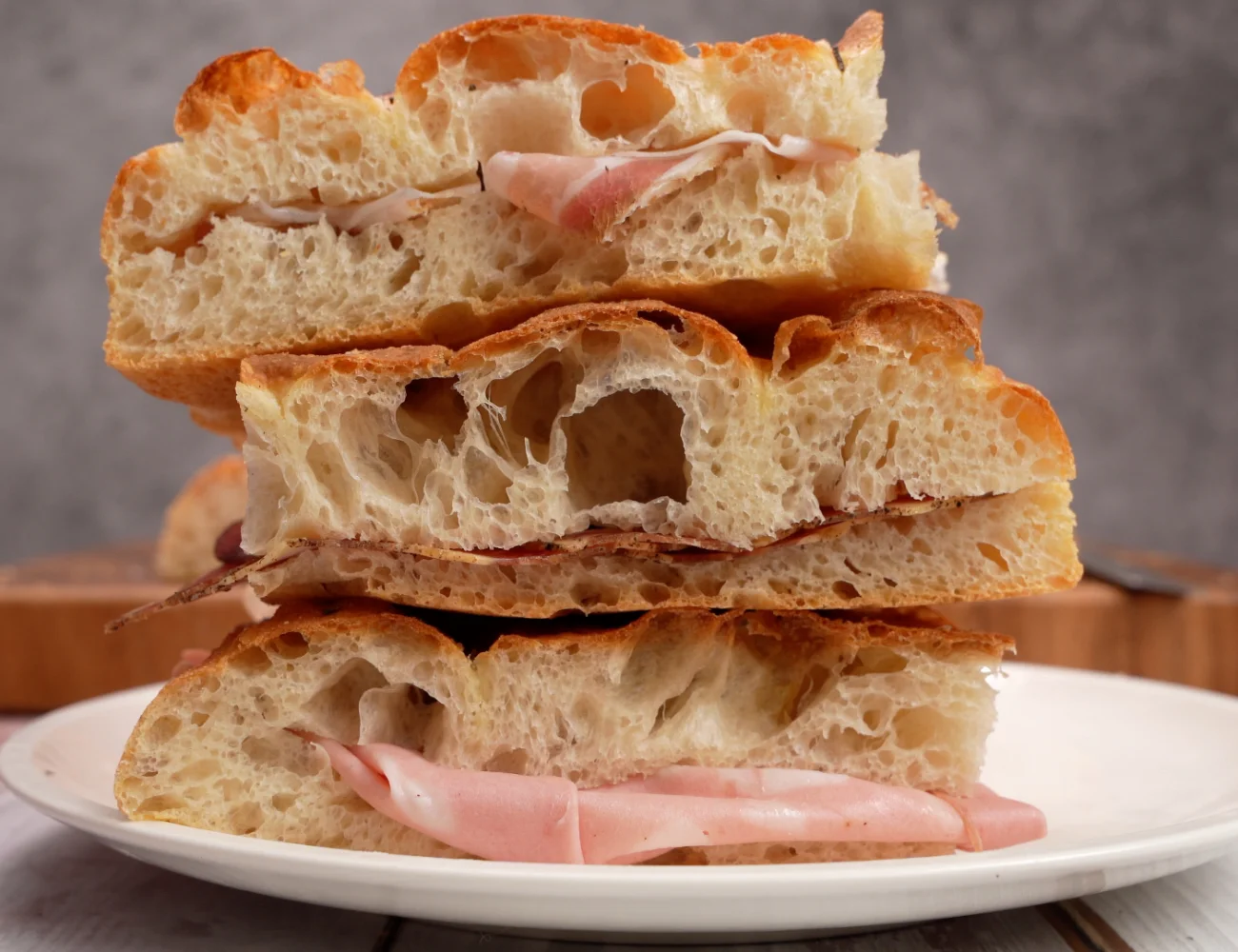
Watch the Video Recipe!
Learn how to make No Knead Italian Focaccia in this video recipe, filmed in Italy:
Subscribe to our YouTube Channel
More video recipes? Subscribe to our YouTube Channel (it’s FREE) and click the bell to get notifications when we release a new video recipe!
About No Knead Focaccia Bread
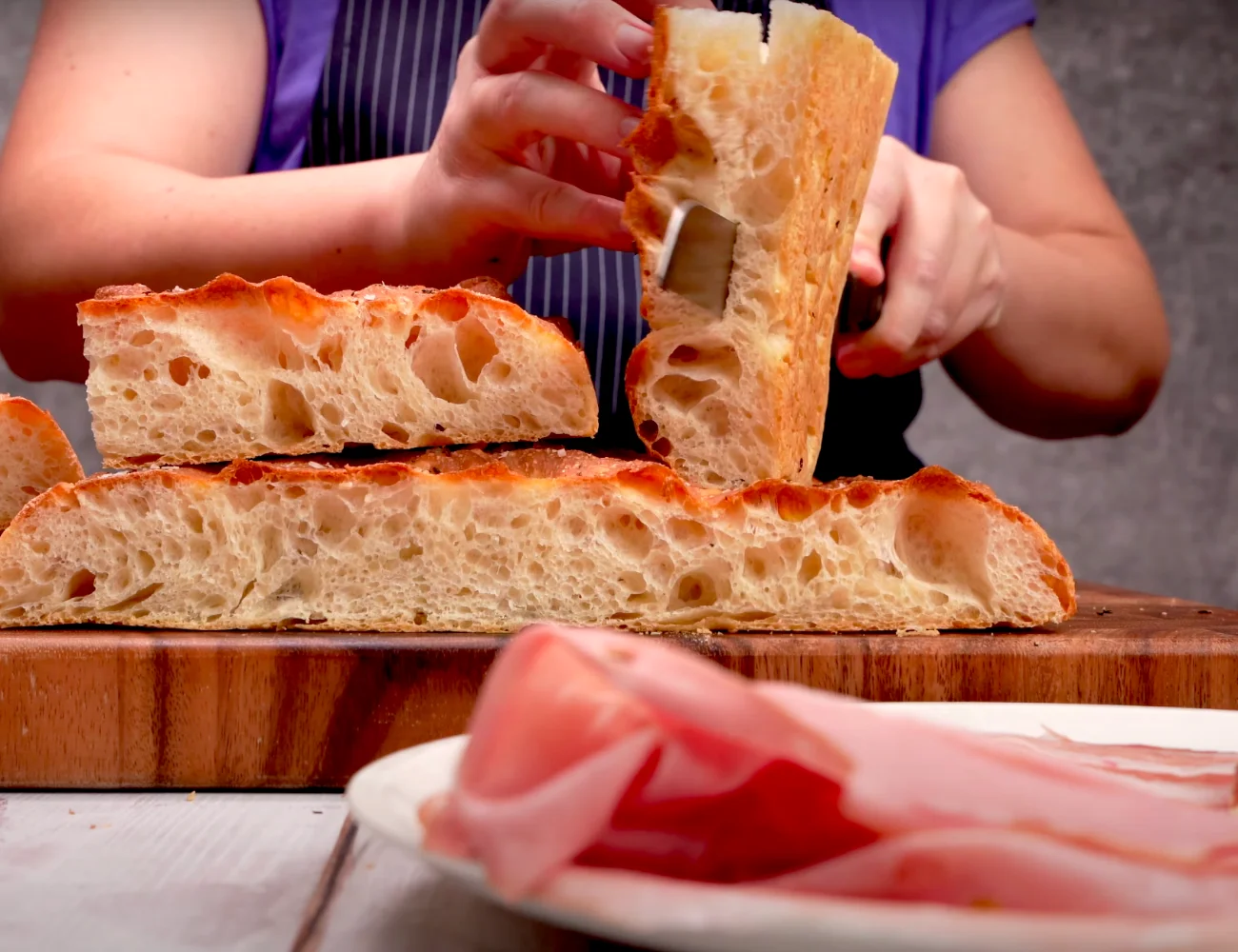
They say that Italy is the country of the 3 P’s: Pizza, Pane (Bread) and Pasta! But it’s also the land of focaccia bread.
There are many varieties of focaccia in Italy, that vary by region and type. However, the focaccia bread recipe that we share with you here is one of the most popular. This focaccia recipe is ideal as sandwich bread. Tall, with a crispy crust and so soft inside —with big bubbles and a great texture.
The secret? A high hydration dough (85% water). Thankfully, the tastiest focaccia is also the easiest to make. We’ll show you how to make this focaccia recipe without kneading with your hands or a stand mixer. A few simple folds is all you need to create a lovely structure that will blow your mind.
Have you had trouble working with high hydration dough in the past? For instance, do you have a hard time working high hydration pizza dough? Check out the video recipe above to see how easy it is to work with this type of dough.
Focaccia Bread Recipe Ingredients
- flour (bread or pizza): roughly 5 cups (600 g) —we recommend weighing ingredients
► WHAT WE USED (affiliate link): Caputo Chefs Flour for Pizza and Bread (2.2 LB; Case of 10): https://amzn.to/3F8vo77
- dry yeast: 3 g (1 tsp)— 0.5% the weight of the flour
► WHAT WE USED (affiliate link): Caputo Active Dry Yeast: https://amzn.to/3q67eWq
- water: 310 g (1 1/3 cups)
- whole milk: 200 g (3/4 cup)
- olive oil: 10 g (1 tbsp)
- salt: 15 g (2 1/2 tsp)— 2.5% the weight of the flour
TOPPING OPTIONS
- rosemary (optional)
- salt: coarse or flake
Which Flour to Choose?
For high-hydration doughs—greater than 80%—you should use a strong flour. In other words, you should use a flour with high gluten content.
The strength of flour is represented by a “W” on flour products. Strong flour should have a “W” greater than ‘300.’ This strength of flour can hold a lot of water and still maintain its structure.
Avoid Weak Flours
Do not choose a weak all-purpose flour for this no knead focaccia recipe. With this amount of water, it will be difficult to get a great rise. If you would like the results you see in the photos and video— soft inside with a great crunch outside—choose a strong flour as we’ve suggested.
Specific Flours We Love!
We have tried many flours when making focaccia bread recipes and pizza dough. Our absolute favorite (up till now) has been a brand of flour that is famous in pizzerias in Italy: Caputo (affiliate link)!
Here are the products that we used in the video to make our No Knead Focaccia Bread recipe. These are Amazon affiliate links, since this brand is not usually found in supermarkets (even in Italy) :
- Caputo Chefs Flour for Pizza and Bread (2.2 LB; Case of 10): https://amzn.to/3F8vo77
- Caputo Active Dry Yeast: https://amzn.to/3q67eWq
- Caputo Semola Flour: https://amzn.to/3F9Mdi7
Proofing and Yeast Quantities
The amount of yeast is calculated for the length of time that you plan to proof. This focaccia bread recipe is designed to proof 6-7 hours at a temperature of around 70°F (21º C).
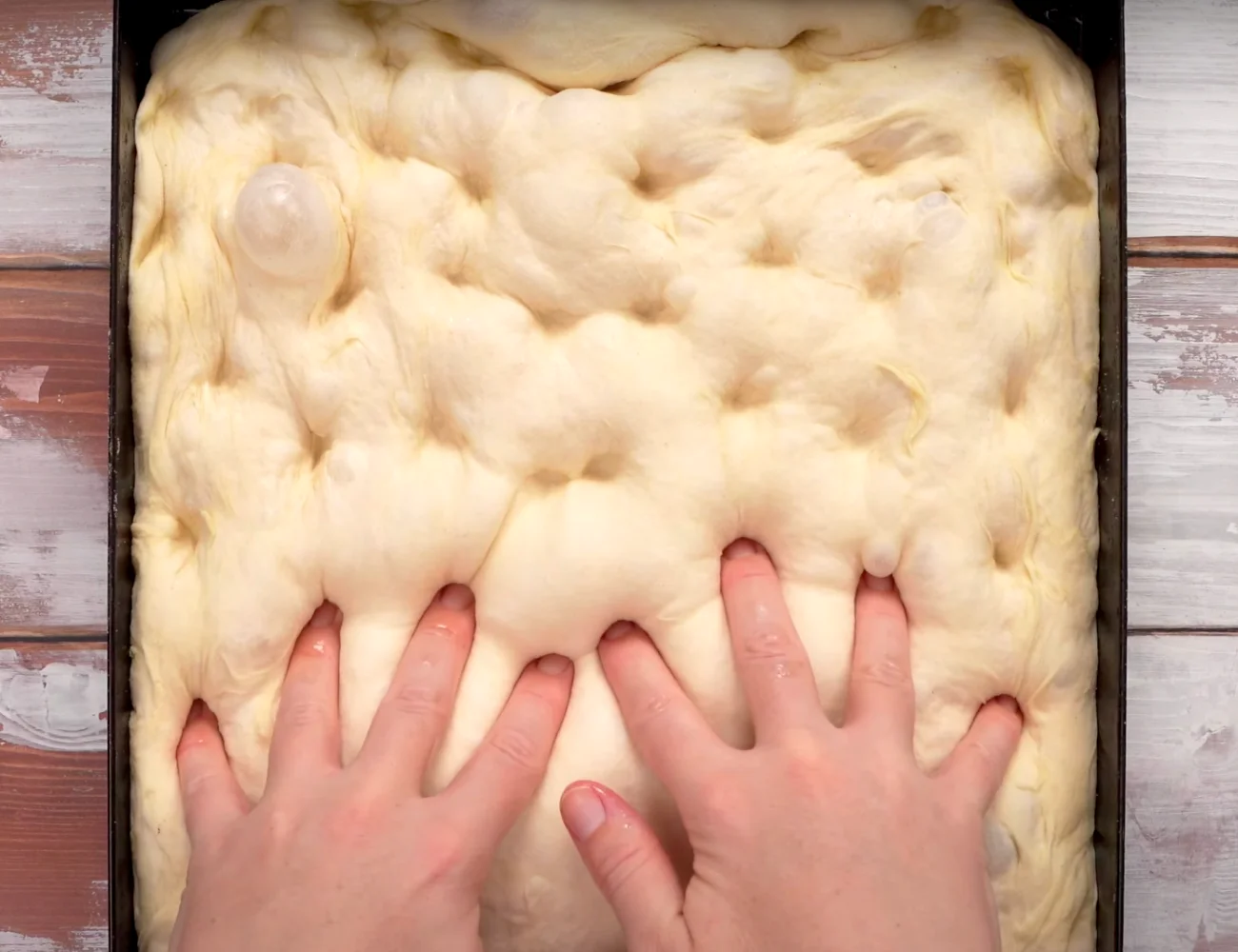


How to Make No Knead Focaccia Bread



Combine the Liquids
To make this No Knead Focaccia Bread recipe, we start by combining the liquid: water and whole milk. The liquids in total represent 85% by weight with respect to the flour.
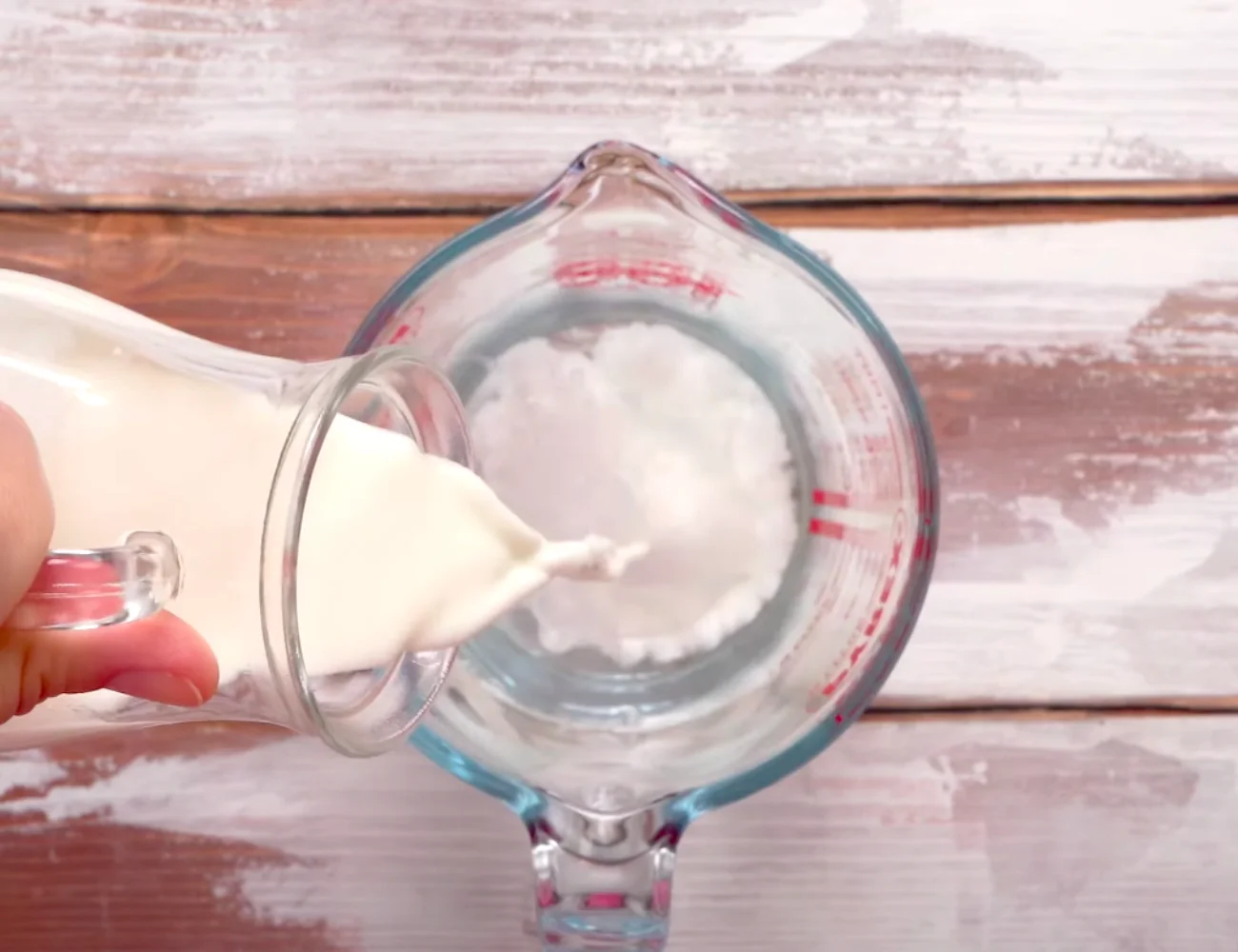

We will be adding some extra virgin olive oil as well, which we have not counted as a liquid. It is usually not counted in the hydration percentage.
Combine the Flour and Yeast
Then, add the flour. Since we’re making a highly hydrated dough, we need a strong flour —a bread or pizza flour. The ‘W’ should be least 300 if not more, as we previously discussed.
Add the yeast to the flour and mix it well. We use a brand of yeast that we can mix directly into the flour. Because it’s already activated, we need just 3 grams (about 1 teaspoon) —for a rise of about six to seven hours at a temperature of about 70° fahrenheit ( 21° celsius).
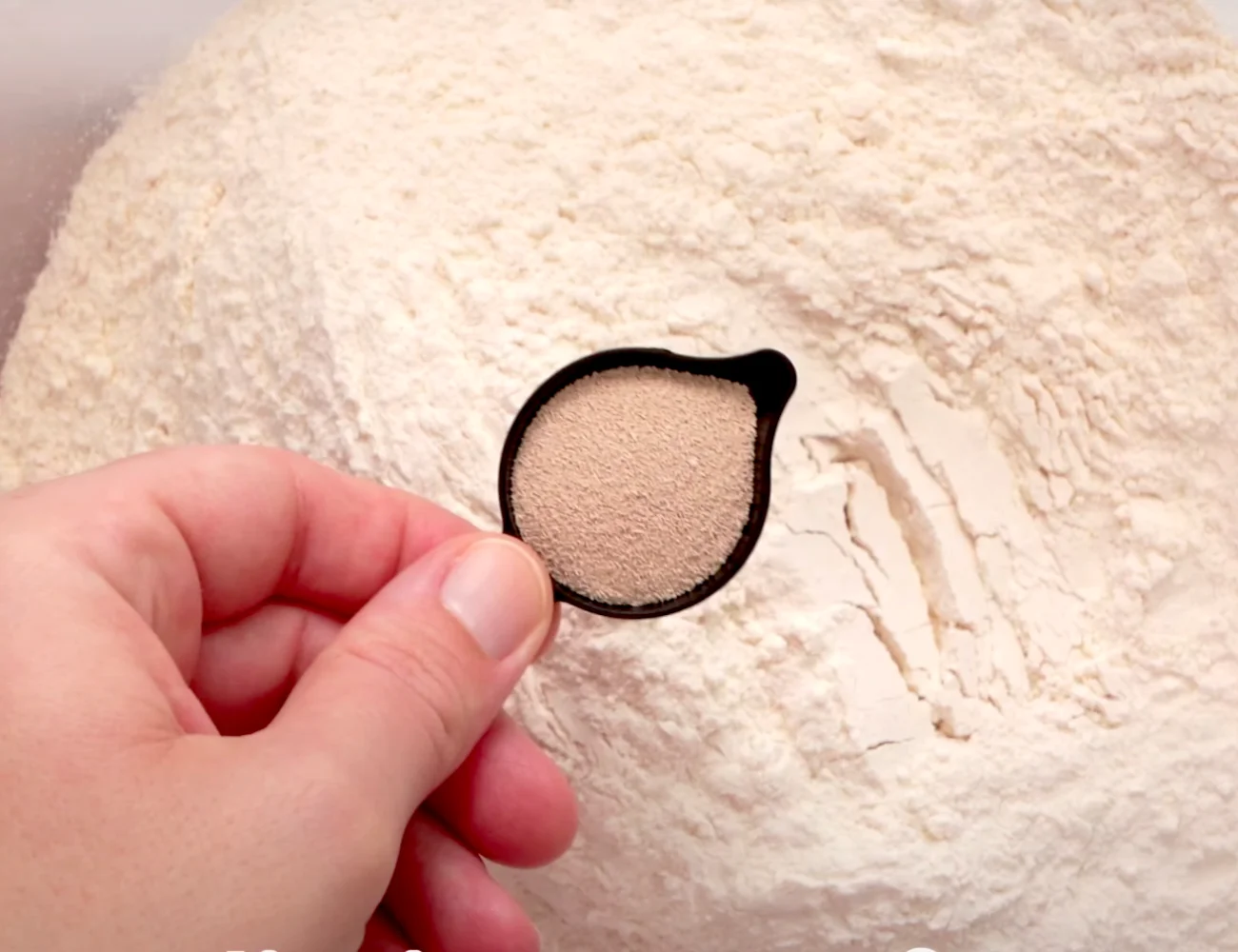

Make the Dough
Add the liquids to the flour and yeast. You can simply use a large spoon to do this job.
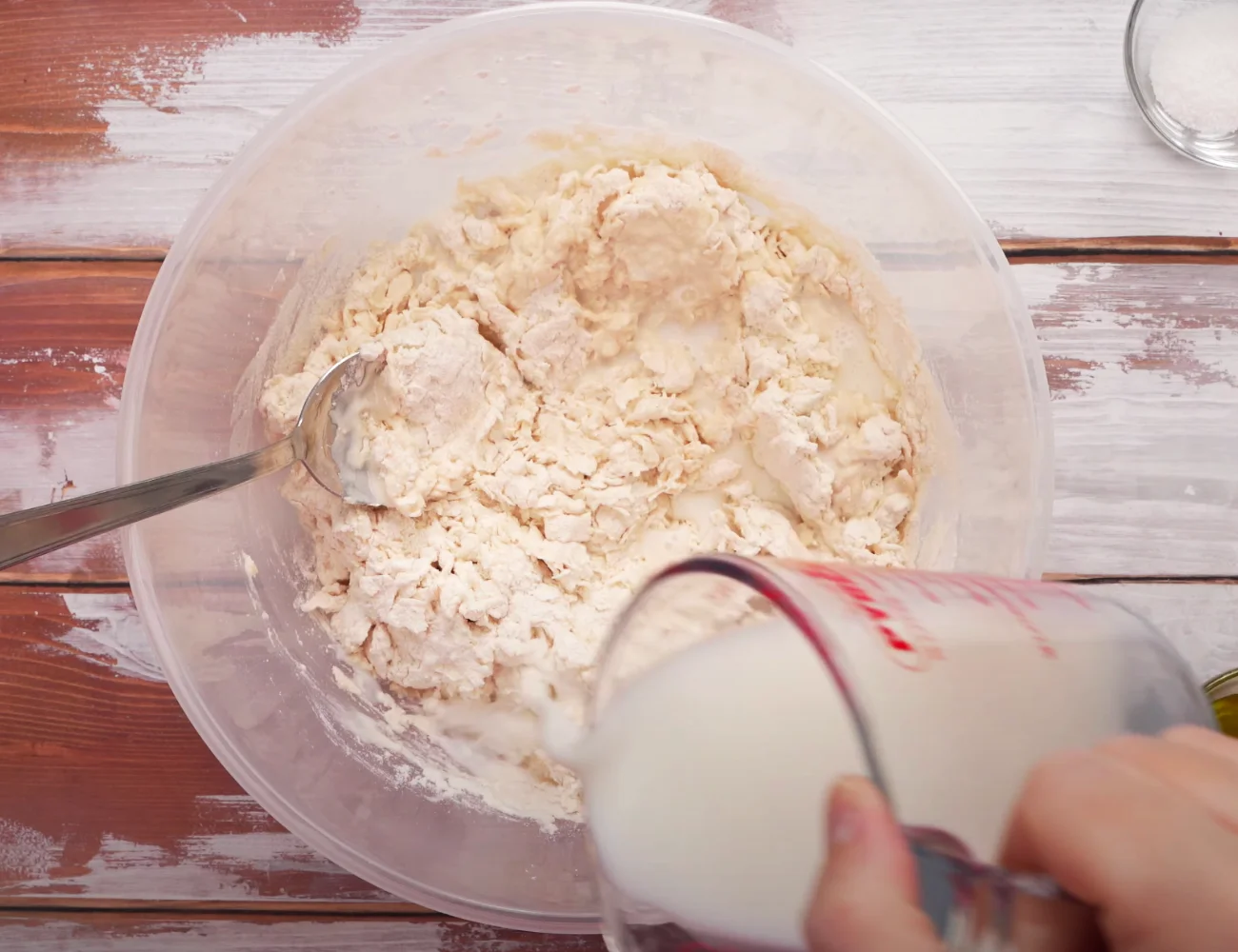

Then add the olive oil.
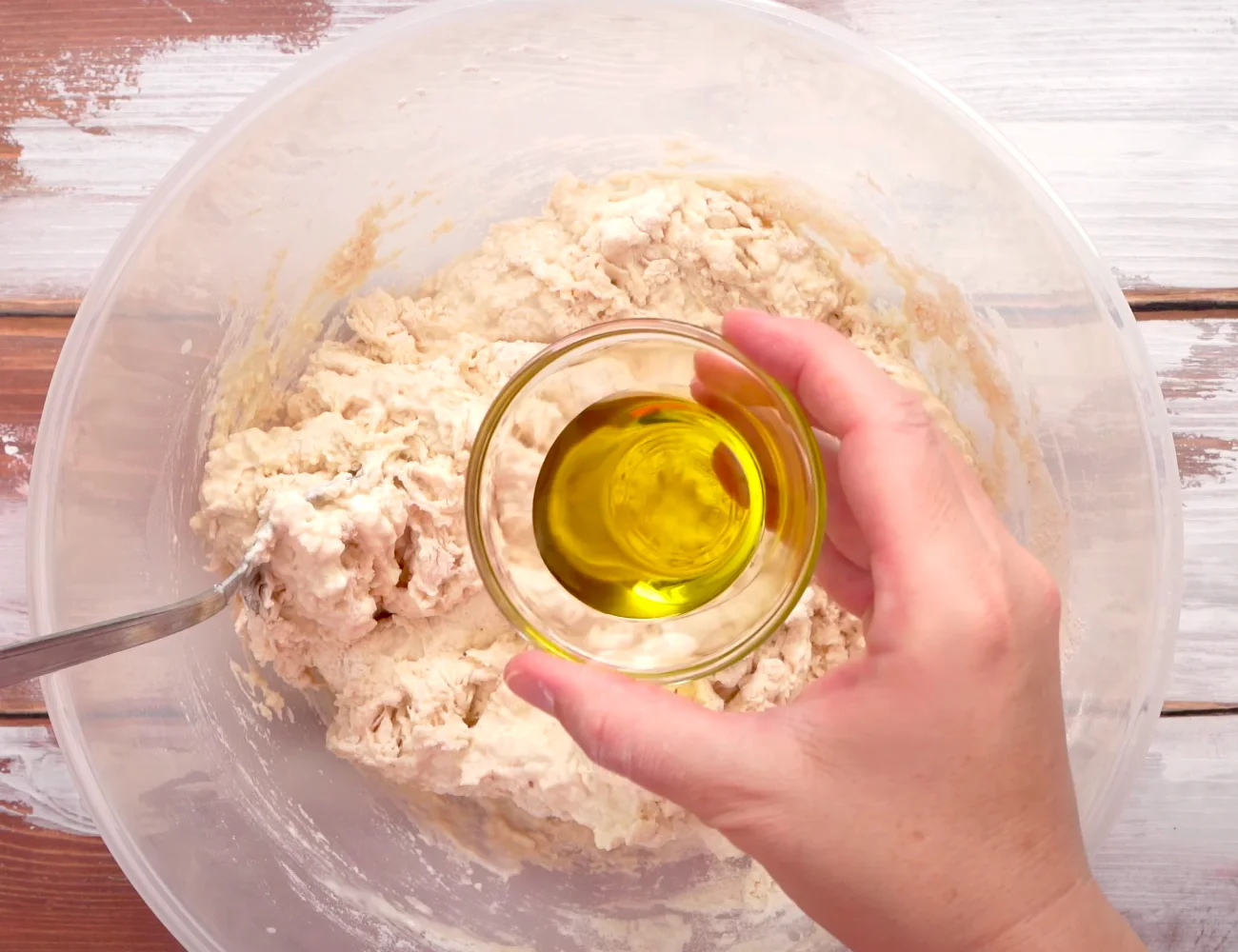

After the mixing is done, mix in the salt as well. Salt can inhibit yeast, so we don’t want to add salt and yeast next to one another at the beginning.
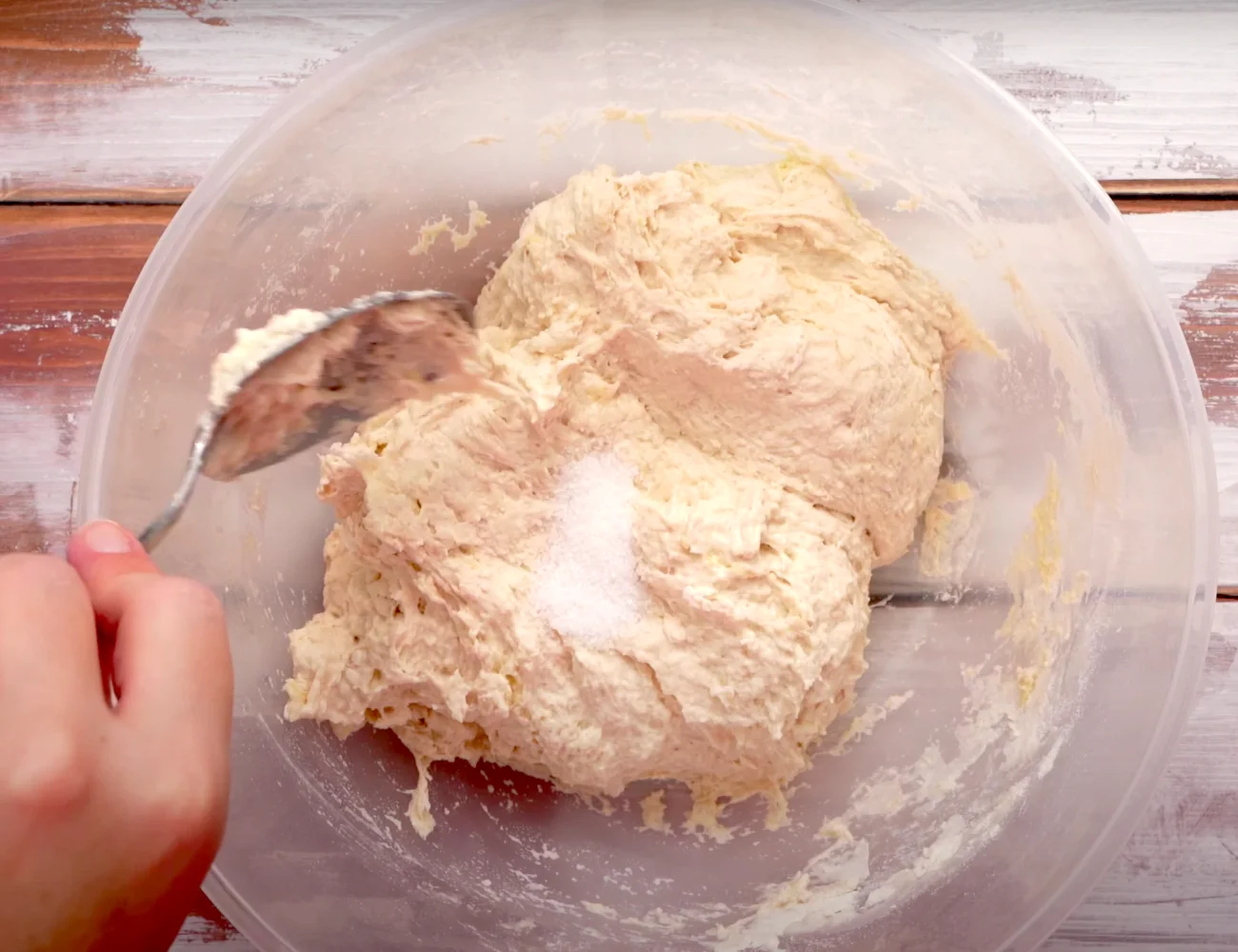

Due to the high hydration, this is a focaccia bread that will not require any manual kneading or stand mixers. The dough itself will do the work for us.
Let it rest (covered) for about 20 minutes.
Then, we just need to make a series of easy folds to give our focaccia a shape that can trap air! This is a lot less work than kneading, and it is perfect for bread beginners!
How to Work with Sticky High Hydration Dough!
There’s no changing the fact that high hydration dough is sticky! However, by adding a small—SMALL— amount of olive oil to the work surface and your hands, we can easily work with it.
3 Rounds of Folds- Every 20 minutes
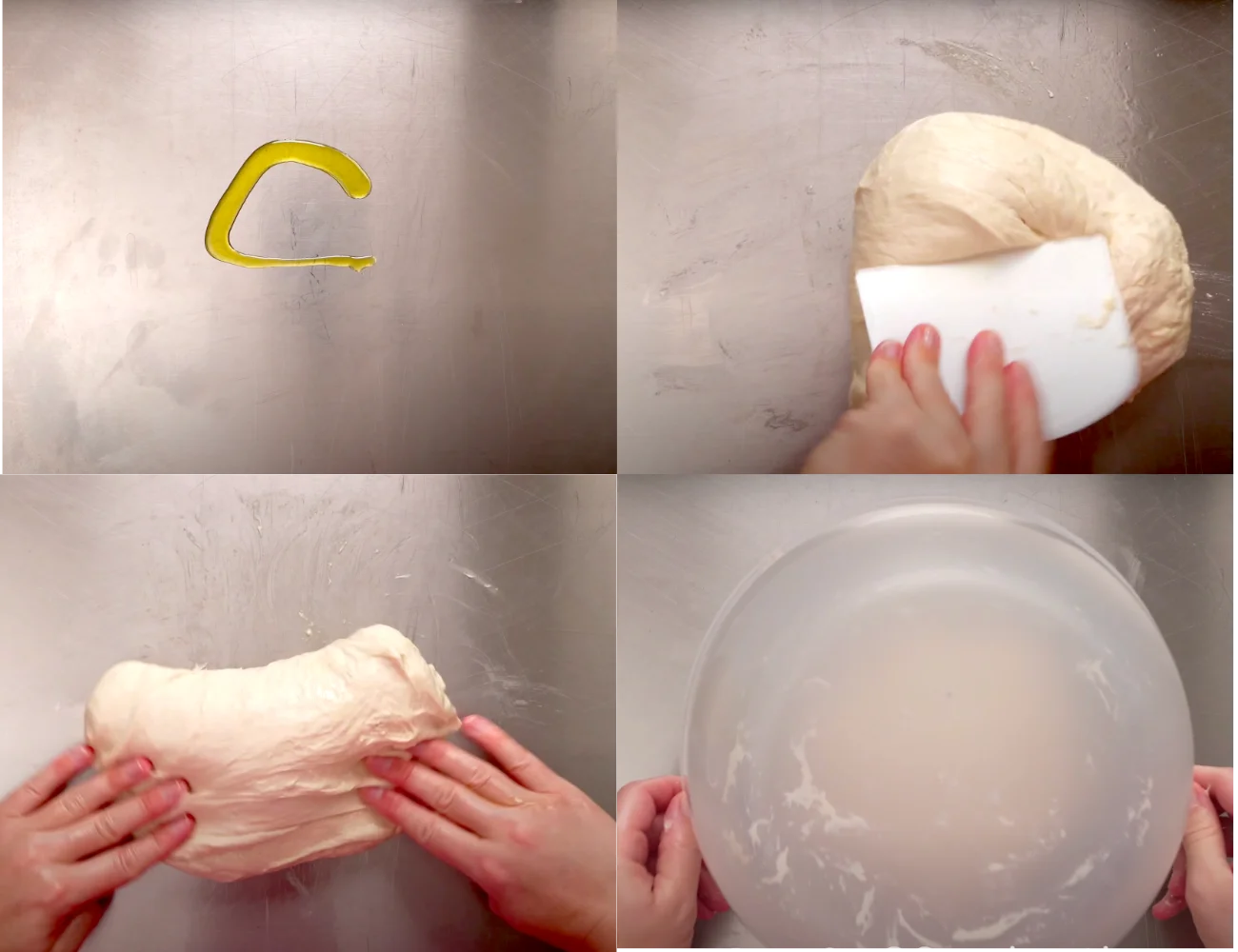

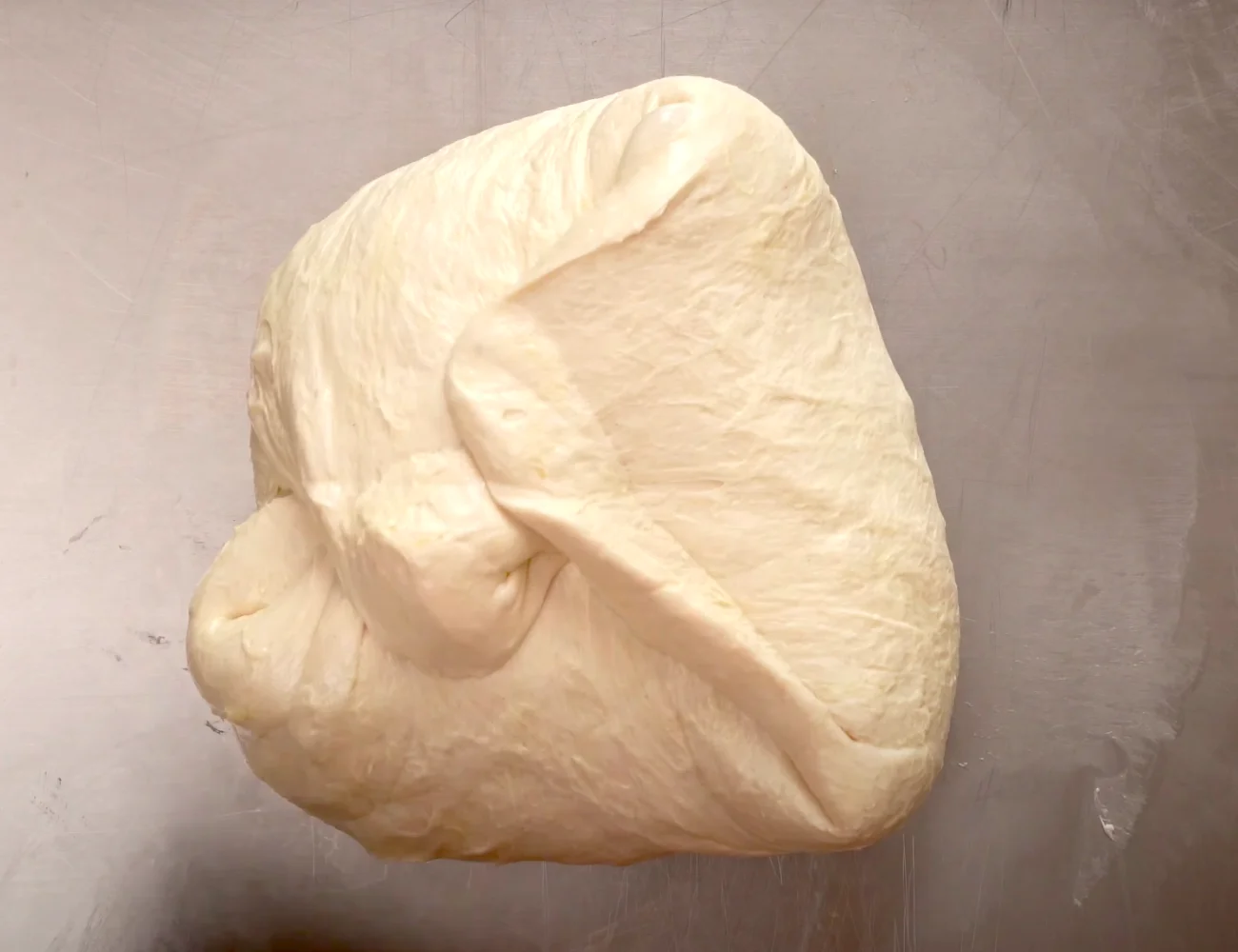

Start making a round of folds. Use whichever technique you prefer. It is not how you make the folds, but the result that matters here. We are simply looking to give the dough a rough ball shape. Keep folding—book, letter folds, whatever—until you can’t fold any more.
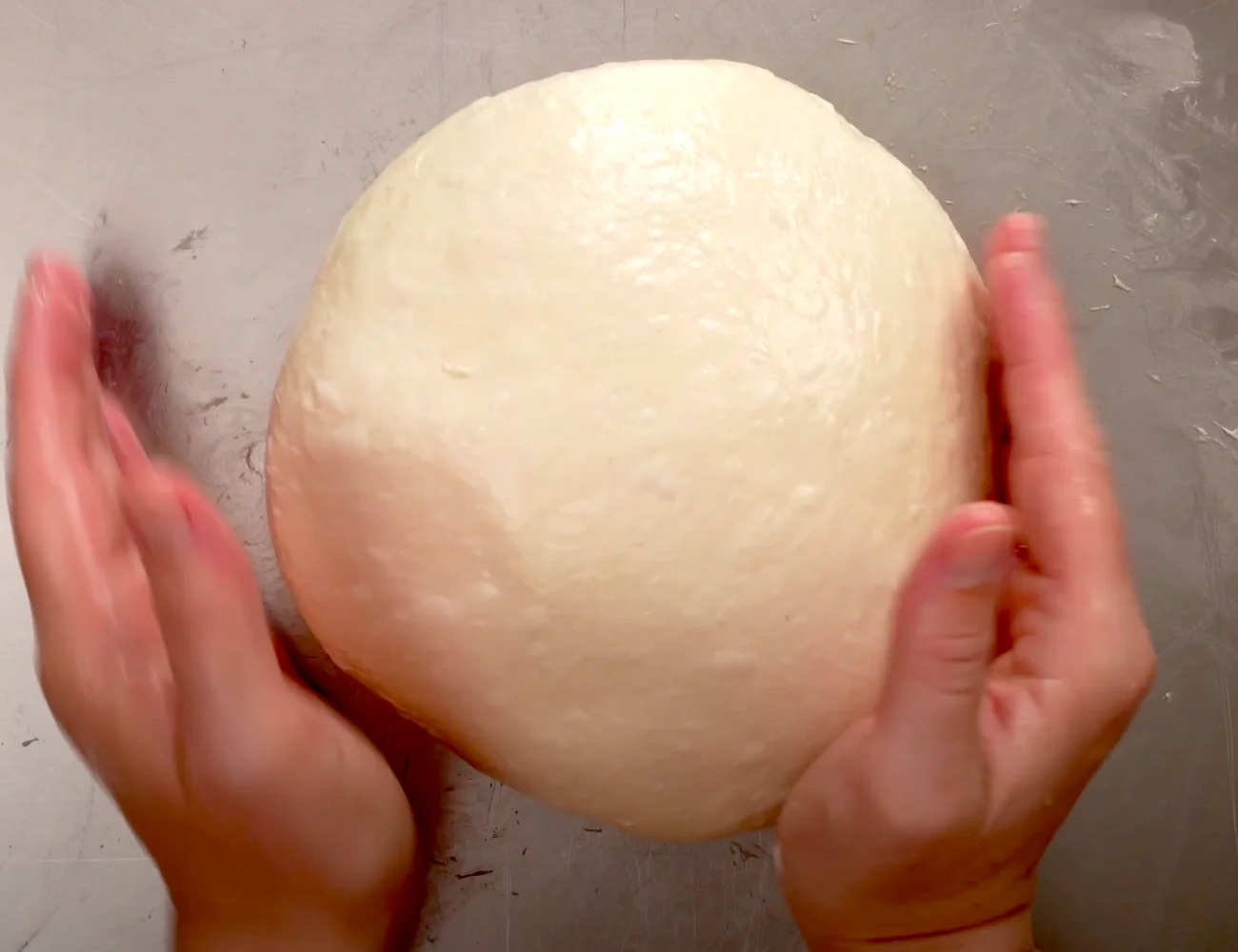

Our focaccia dough won’t be a perfect ball yet —it’s still too wet. No problem! We will repeat the process two more times, and each time the dough will take on a better shape. Please watch our video above—a video is worth a thousand words!
Cover and let the dough rest for 20 minutes. Then, give the dough another round of folds.
Cover again, let the dough rest for 20 more minutes and give it a final round of folds!
Why Are Folds Necessary?
Imagine that your gluten is like cement. Want to make a wall of cement? Poured cement alone will run and create an amorphous shape—not useful! However, if you create a structure in which to pour the cement, then it will dry into a useful shape.
The same applies to dough. We fold to give our gluten a structure in which to grow. The gluten mesh that develops in this way will increase the strength of our dough which otherwise would collapse. It’s this structure which gives our focaccia recipe the lovely big bubbles you see in the pictures!
1st Dough Rise— Container
Cover and let the dough rest for two hours —or until it doubles in size!
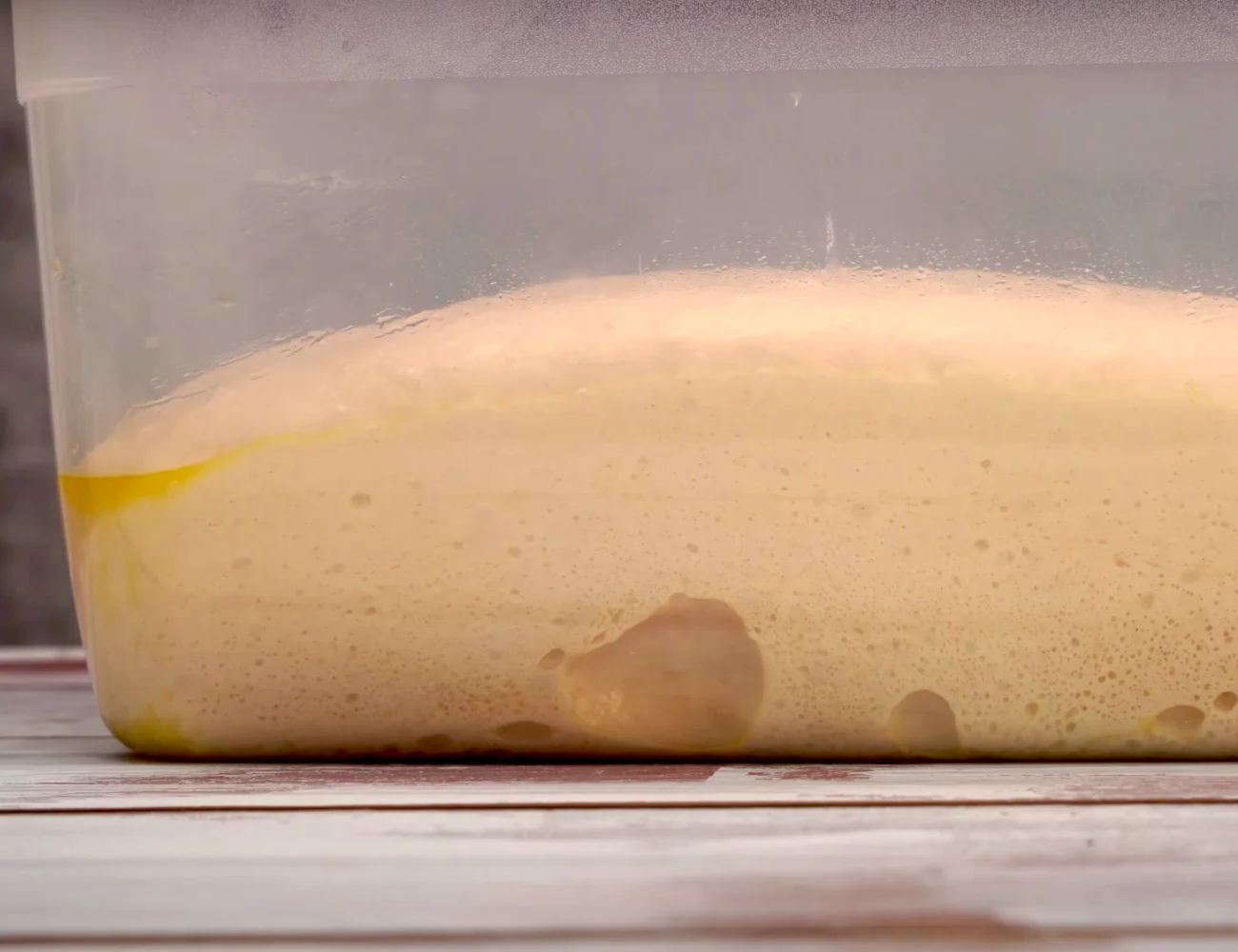

Believe it or not, the shape of the container that the dough rises in does matter here! It’s best to choose a container with the same rough shape as the pan you plan to bake the focaccia in. Here, we will bake in a rectangular baking tray, so we are letting the dough rise in a rectangular container.
It’s not critical to choose a container with the same shape as your baking tray. However, if you do, stretching the dough to the size of the baking tray will be much, much easier!
More Folds!
Time to make our last round of folds. Add a tiny bit of oil to the work surface as always. Turn the container over and just let the dough slowly slide out onto the work surface. It will be full of air!
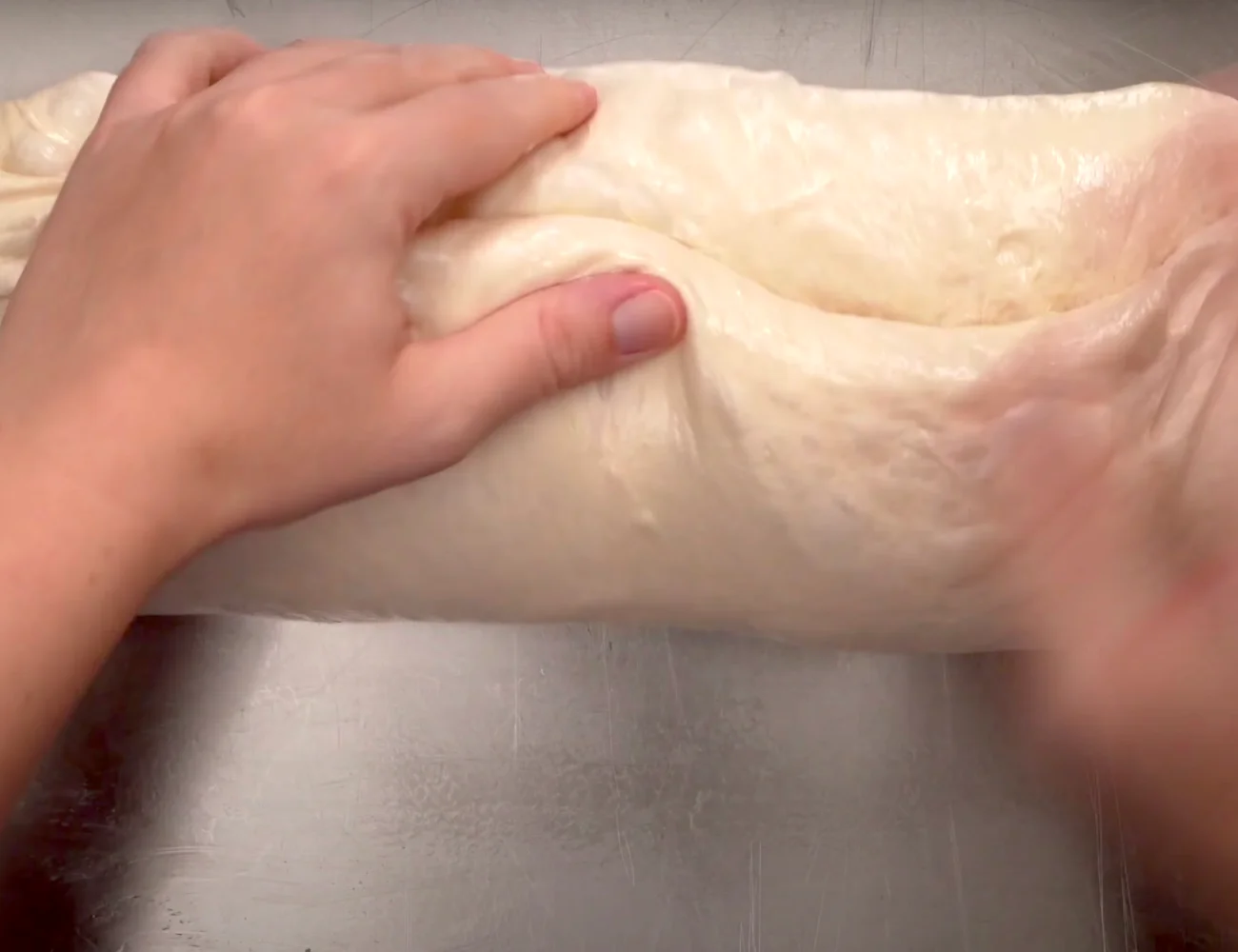

Fold the dough in on itself a few more times to trap even more air. Continue folding the dough until it is really filled with air like a balloon that is about to burst.
When you struggle to make any more folds, that is the time to stop. Place it back in the covered container and let the focaccia dough rest for another hour to let it relax a little bit.
2nd Dough Rise— Baking Tray
After the hour, transfer the dough to your work surface —this time dusted with semolina flour. Once again, just let the dough fall from the container. Pull the dough from the edges to stretch it to roughly the size of the baking tray.
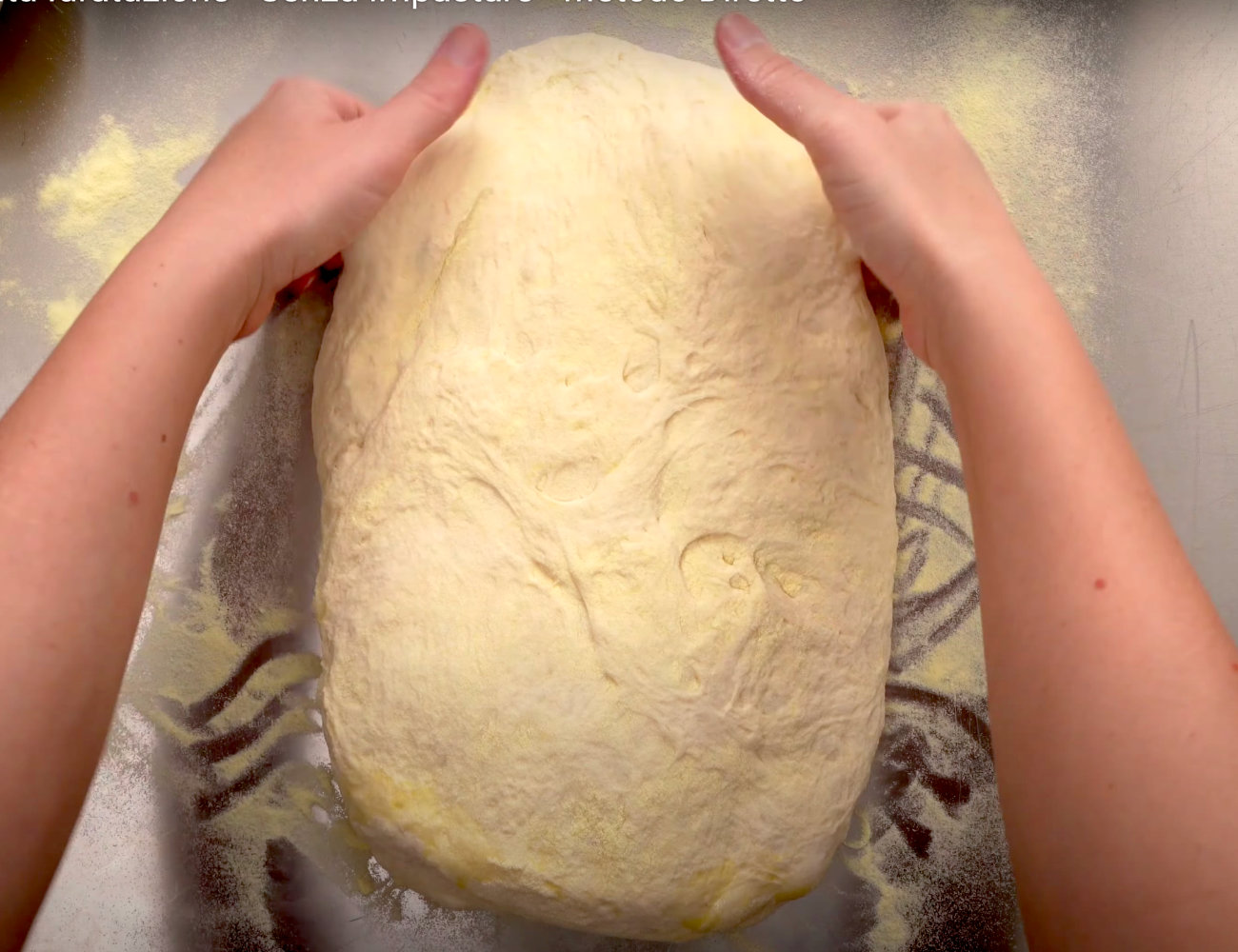

Then, transfer the dough to baking tray for the second rise.
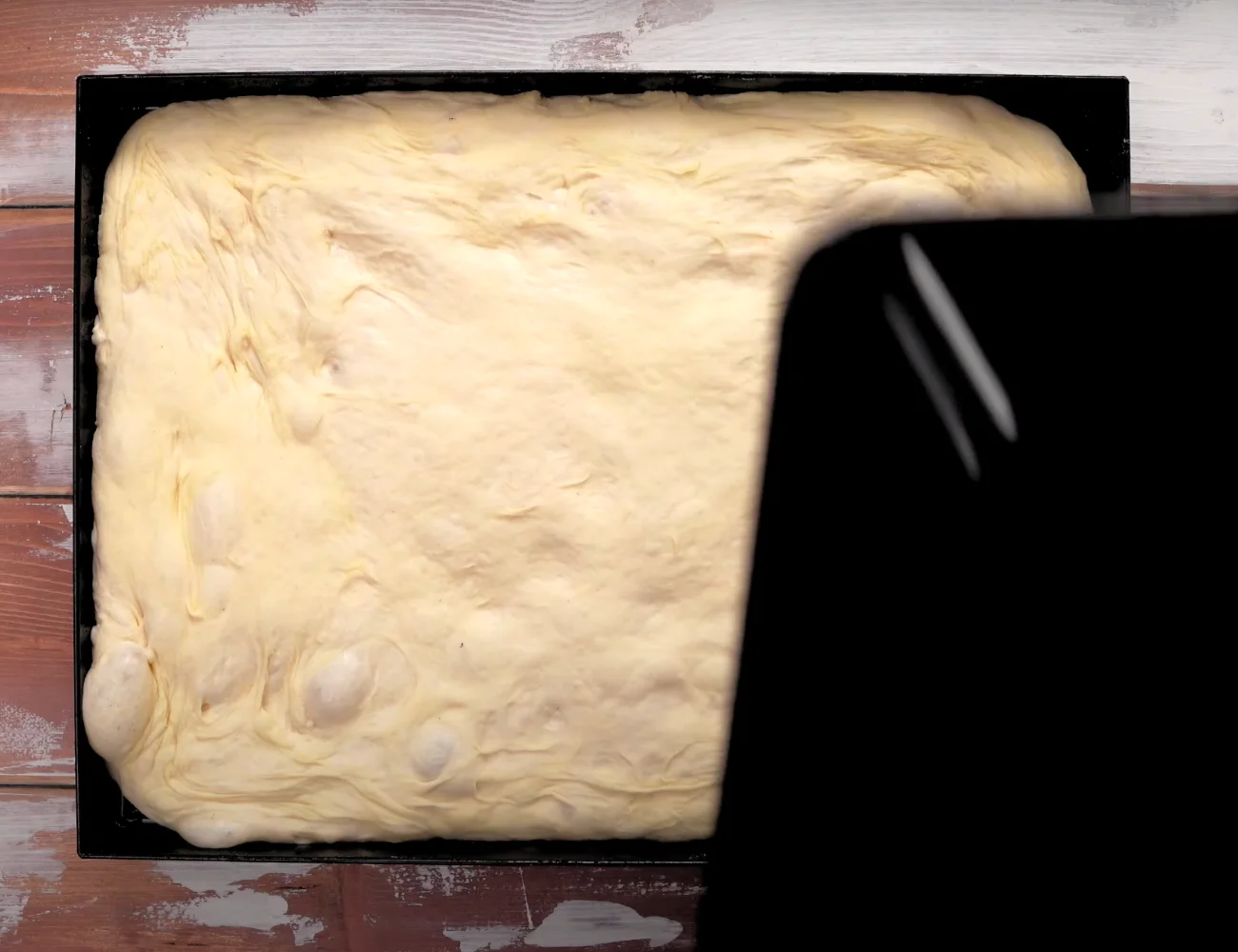

The focaccia dough may still spring back a bit when you try to stretch it. This is normal given the amount of folds that we gave it. And remember: our dough still has to rise in the pan during which time the gluten will also continue to relax.
Cover the let the dough rise for 2 more hours.
Bake the Focaccia Bread
Time to bake! Now’s the time to prepare any toppings you like: for instance, rosemary and coarse or flake salt.
It’s finally time to make the famous fingertip indents that are typical of Italian focaccia bread. If necessary, wet your fingers with oil. Press down and away from you to make the indents.



Bake the focaccia in a static, preheated oven at 430° F (220° C) for 20 minutes.
Then—if you have this oven option—finish baking the focaccia bread at the same temperature using convection or fan for about 10 more minutes. This will create an even crispier outer crust. We want the focaccia browned—not burned— so watch the bread carefully at this point and judge by eye.
Our beautiful focaccia is ready! It’s a focaccia that was created to be stuffed with something delicious! We love to fill ours with cold cuts ( affettati in Italian)—such as mortadella which is not the bologna found abroad.
You can even stuff the focaccia with vegetables! Try broccoli rabe (cime di rapa in Italian) or a combination of vegetables and meat. For example, spinach and sausage are a delicious mix. Buon appetito!
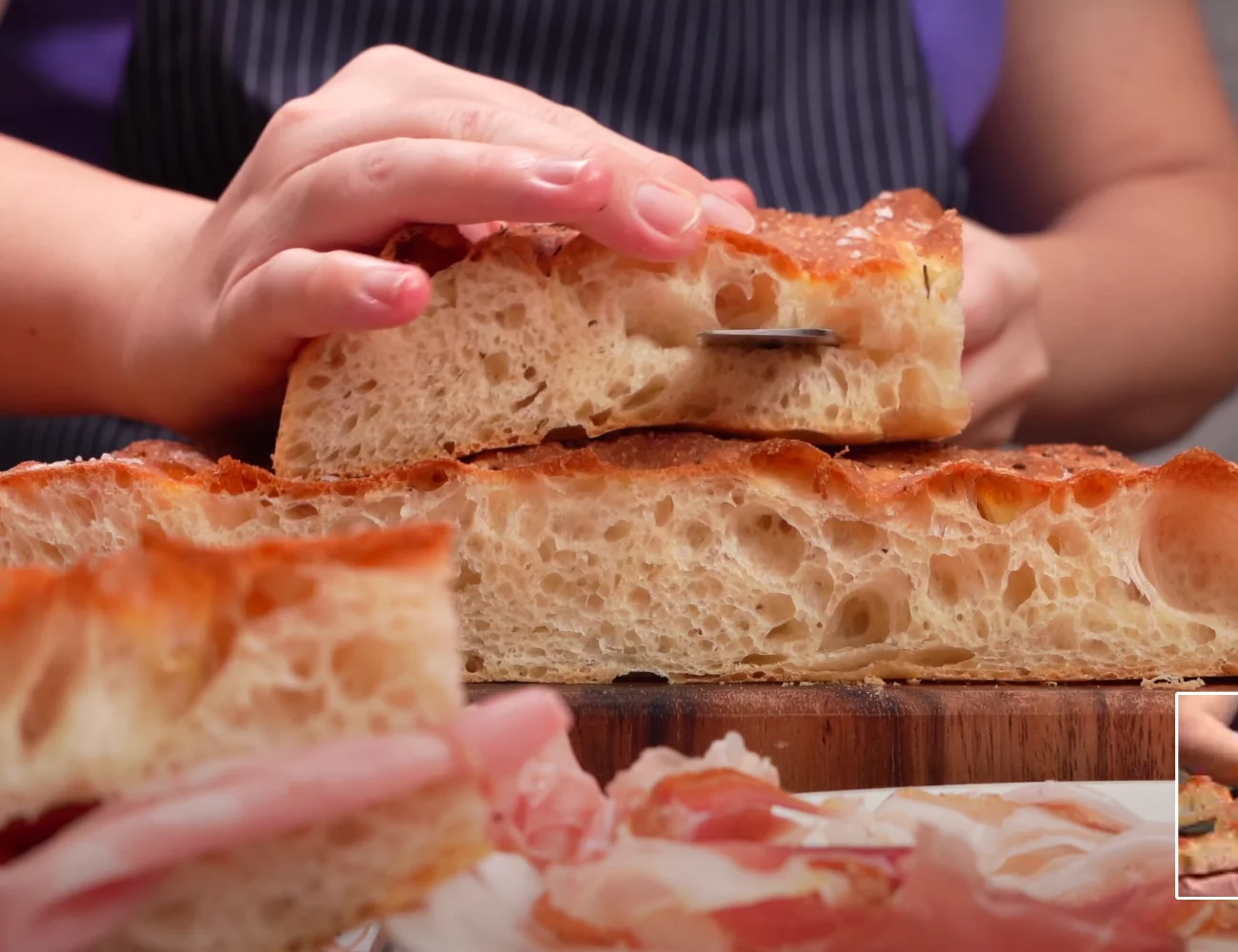

Discover More Italian Focaccia Recipes!
Discover More Italian Food Recipes
As an Amazon Associate, we earn from qualifying purchases. This means at no extra cost to you, PIATTO may earn a small commission if you click the links and make a qualifying purchase.
No Knead Focaccia Bread Recipe
Equipment
- 1 pastry cutter optional
- 1 large mixing bowl
- 1 large proofing container rectangular for a rectangular bake
- 1 baking tray
- 1 kitchen scale optional but recommended
Ingredients
- 5 cups strong flour bread or pizza (see notes)
- 1 tsp dry active yeast
- 1 ⅓ cup water
- ¾ cup whole milk
- 1 tbsp olive oil
- 2 ½ tsp fine salt
- fresh rosemary optional topping
- coarse or flake salt optional topping
Instructions
Make the Focaccia Dough
- Combine the water and milk (liquids) in a small bowl or cup.¾ cup whole milk, 1 ⅓ cup water

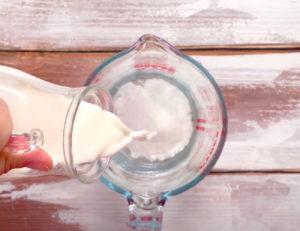
- Combine the yeast with the flour in a large mixing bowl.1 tsp dry active yeast, 5 cups strong flour

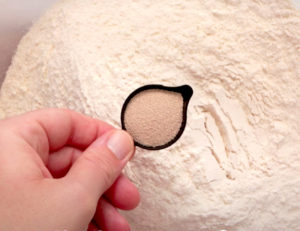
- Slowly add the liquids to the dry ingredients, using a large spoon to combine the ingredients.

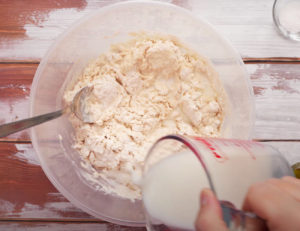
- Mix the olive oil into the dough.1 tbsp olive oil

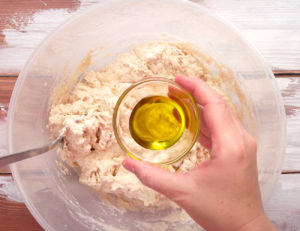
- Mix the salt into the dough.2 ½ tsp fine salt

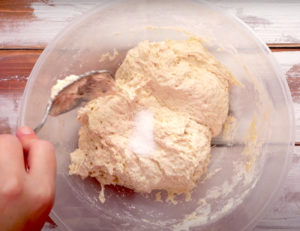
- Cover and let the dough rest for 20 minutes to relax.
Fold the Dough (3x)
- Transfer the dough to a very lightly oiled work surface. Using lightly oiled hands and / or a pastry cutter, give the wet dough a round of folds. Cover and let the dough rest on the table for 20 minutes.

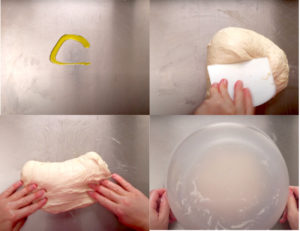
- Do a 2nd round of folds. Cover and let the dough rest 20 minutes.
- Do a 3rd round of folds. Transfer the dough to a rectangular container for the first rise.

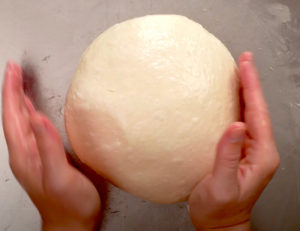
1st Dough Rise (Container)
- Cover the dough and let the dough rise until doubled in size—a few hours.

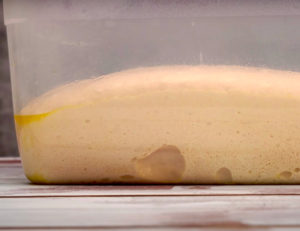
- Transfer the dough to the work surface and give the dough (now full of air) a few more folds. Then put it back in the container (covered) for another hour.

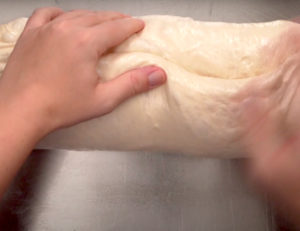
2nd Dough Rise (Tray)
- Dust the work surface with flour (semolina is best). Let the dough fall out of the container onto the work surface. Gently pull the dough to stretch it to roughly the same size of your baking tray.

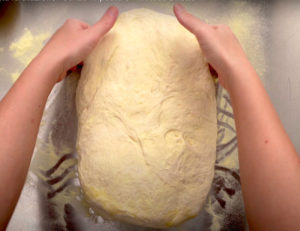
- Transfer the stretched dough to the baking tray. Cover and let it rise for 2 more hours.

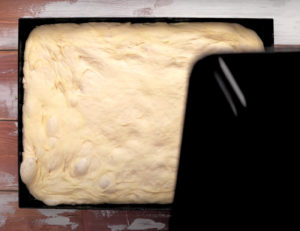
Bake the Focaccia
- Make indents in the focaccia with your fingertips (pushing down and away from you).

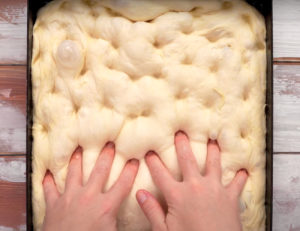
- Brush a thin layer of olive oil onto the top of the focaccia. Add fresh chopped rosemary (optional) and a sprinkle of coarse or flake salt.fresh rosemary, coarse or flake salt
- Bake the focaccia in a static, preheated oven at 430° F (220° C) for 20 minutes. Turn the oven to 'fan' and bake for another 10 minutes at the same temperature. Or, bake until golden brown. Buon appetito!

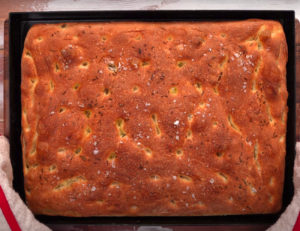

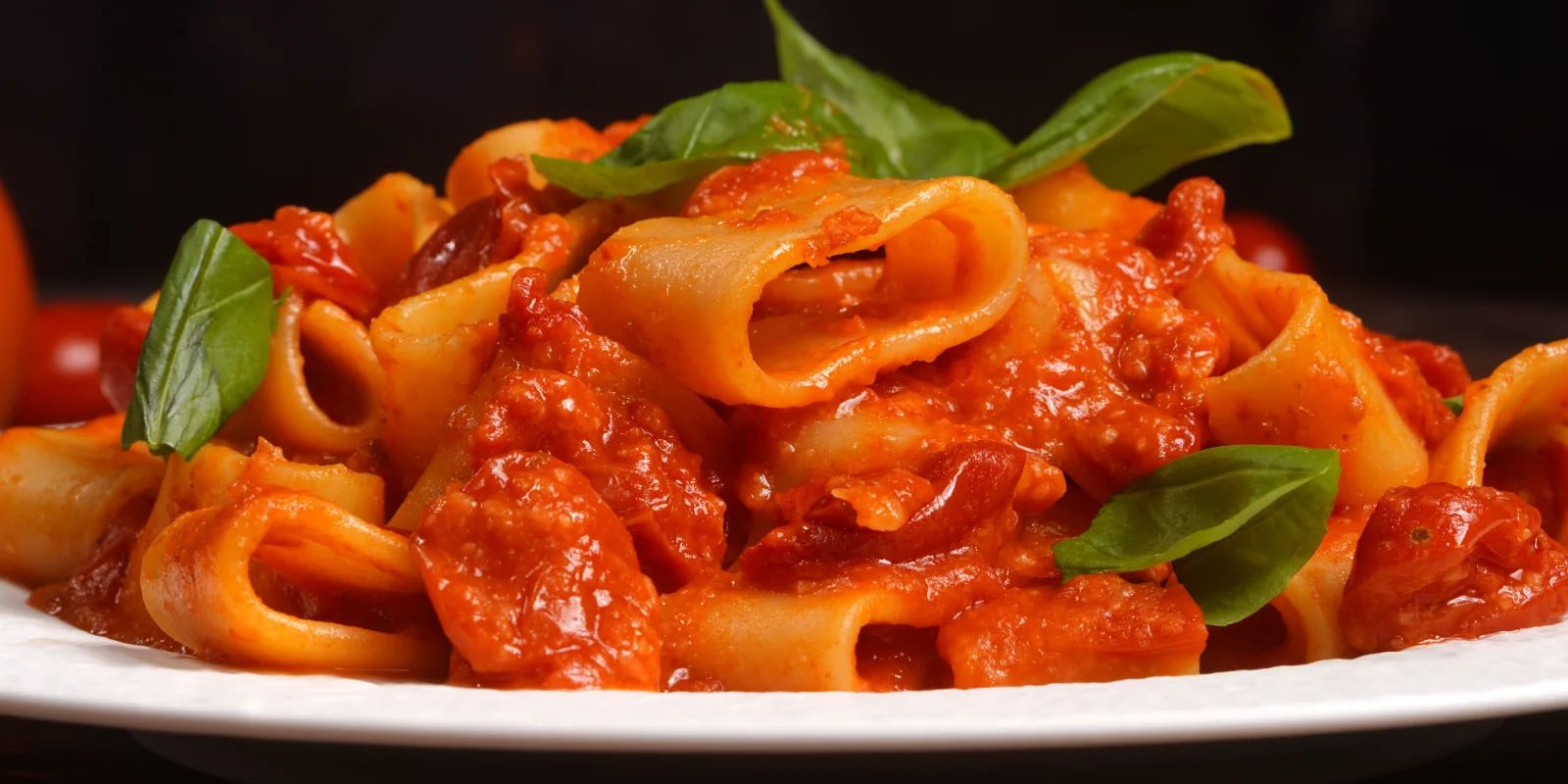
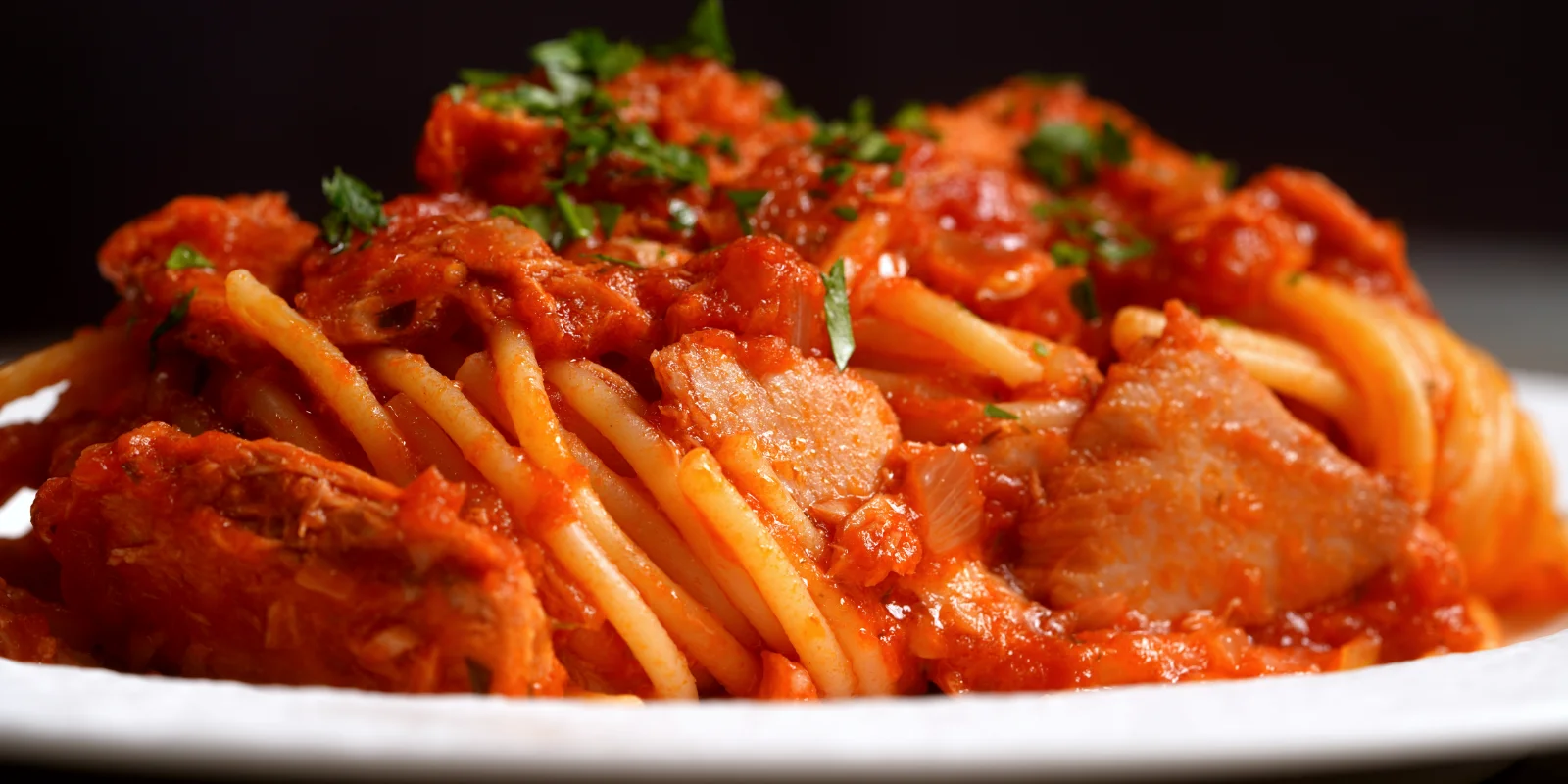
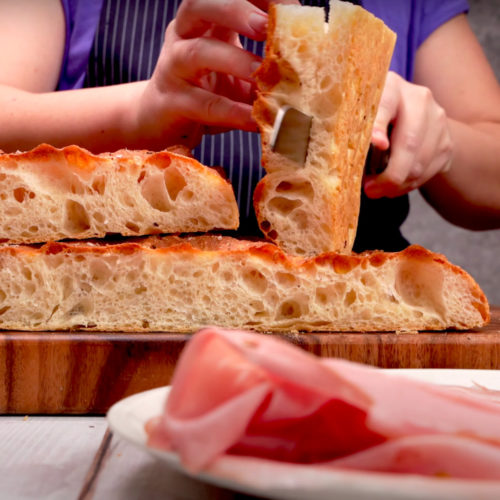

“Complimenti… è splendivigliosa 🤩😍👍”
Ottima
“Bravissimo ottimo e buonissimo. Lo rifarò. Sicuramente.. Procedimento. Ottimo. 👍💪👏👏👏😘🤩”
“L’ho fatta oggi, davvero fantastica, grazie per la ricetta!”
“Da manuale 😋😋😋”
“Provata…. PERFETTA
GRAZIE”
“L’ho fatta oggi , ottimo,alla fine sembra di avere in mano un palloncino pieno di gas elio ,come quei palloncini che vendono su le fiere . Ottimo 👍”
“Complimenti…splendida ricetta”
“Focaccia fatta con il tuo dosaggio ed é venuta buonissima 😋 il mio impasto però era più molle”
“Complimenti siete bravissimi..soprattutto per quanto riguarda riprese e spiegazioni..ottimo lavoro continuate così!!!👏👍🏻”
“Yes, for amateurs 85% liquid is already punishment. 😅 My dough takes rest in refrigerator for minimum 12 hours. But i can’t keep so air inside. 🫤 But everytime i make Foccacia, it becomes better and better. Never give up, the result is worth it. 🤤”
“Molto bravo complimenti!🎉”
“Complimenti…ne ho viste tante, ma bella come questa mai.”
“Fantastica,domani ci provo,non sarò così brava come te,complimenti x le meravigliose ricette che dai”
” 💯💯💯💯💯💯💯💯💯💯👍”
“Meravigliosa”
“Magnifique”
“Grazie per la ricetta 😀”
“Grazie mille per la ricetta sono Paola iscritta da poco ma ho replicato già due volte questa meravigliosa focaccia 😊🤗”
“Ciao , que tipo di FARINA e stato utilisato ?! GRAZIE PER LA RISPOSTA ? 🇫🇷🇮🇪🇫🇷🇮🇪👍👍👍⛱⛱⛱☀️☀️☀”